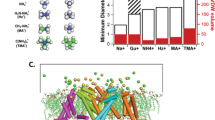Abstract.
Transmembrane ion channels play a crucial role in the existence of all living organisms. They partition the exterior from the interior of the cell, maintain the proper ionic gradient across the cell membrane and facilitate signaling between cells. To perform these functions, ion channels must be highly selective, allowing some types of ions to pass while blocking the passage of others. Here we review a number of studies that have helped to elucidate the mechanisms by which ion channels discriminate between ions of differing charge, focusing on four channel families as examples: gramicidin, ClC chloride, voltage-gated calcium and potassium channels. The recent availability of high-resolution structural data has meant that the specific inter-atomic interactions responsible for valence selectivity can be pinpointed. Not surprisingly, electrostatic considerations have been shown to play an important role in ion specificity, although many details of the origins of this discrimination remain to be determined.
Similar content being viewed by others
Author information
Authors and Affiliations
Corresponding author
Additional information
Received 4 September 2005; received after revision 17 October 2005; accepted 2 November 2005
Rights and permissions
About this article
Cite this article
Corry, B., Chung, SH. Mechanisms of valence selectivity in biological ion channels. Cell. Mol. Life Sci. 63, 301–315 (2006). https://doi.org/10.1007/s00018-005-5405-8
Published:
Issue Date:
DOI: https://doi.org/10.1007/s00018-005-5405-8




